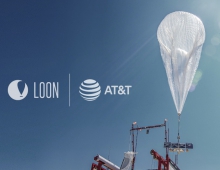
How Software Orchestrates Loon's Balloon-powered Internet
Google has provided some information on how the Loon's ballons network is working in order to provide uninterrupted internet connectivity.
Taking the internet from where it is now and bringing it closer to people who need it is key to the commercial deployment of Loon, which will begin this year.
Loon is able to extend the reach of the internet long distances, and Google has already established a connection that spanned 1,000 km across 7 balloons operating 20 km above the Earth.
Besides the challenge of creating the links that allow the internet to reach further, the orchestration challenge is also big.
When you’re accessing the internet from your phone, your data moves through a set of network nodes, e.g., a cellular tower, a fiber cable, or a network router, whose positions are fixed at their location in the world. The only piece of the puzzle moving is you, so the amount of “mobility” to manage is at the very edge of the network.
This is not the case for Loon. Since our balloons move with the winds, their physical coordinates are constantly changing in relation to the ground, each other, and you.
Suppose your phone is connected to Loon and you hit send on a text message. That message will jump up 20km to a balloon in the stratosphere. It may then hop across two, three, or more balloons to reach one connected to a ground station. Once there, your message will be routed through conventional fiber connections to your mobile carrier.
A few hours later you may send another message to the same person. However, because the balloons have moved in the meantime, it may jump up to a different balloon, hop across different balloons to a different ground station on the other side of the country, and be routed through different fiber connections to your carrier. This may be the case even if you are in the exact same spot and you’ve been online the entire time.
To manage a network like this Loon's engineers need to continually decide which balloons should make connections with which neighboring balloons (a topology) and how data packets should transit the various links to move across the network (routing). The topology needs to be planned not only for where the balloons are now, but also where they will be in the future in order to ensure that when one path becomes obsolete a new path is already in place. The routing needs to happen logically given the topology at any given time and place. The ultimate goal is to ensure that data is constantly flowing across the network in an efficient way, without disruption, even as things are in constant motion.
"Managing this level of complexity means we can’t plan our network just once. We have to do it continuously. And in order to scale we must do it automatically," said Salvatore Candido head of Loon's engineers.
To do this, Loon created a network brain. This custom-built software defined network (SDN) orchestrates Loon’s connectivity efforts. SDN is not a new concept, but what Loon has built is something unique. "It consumes forecasts of the future state of everything in our network — the balloons, the ground stations, even the weather — and then structures connections and routes data to optimize connection speeds, minimize latency, and avoid network disruptions. We call this a Temporospatial SDN. The Loon SDN functions autonomously on a massive scale to ensure people below our balloons have a connection to the internet," Candido explained.
Loon has been selected by Telesat, a leading global satellite operator, to adapt the Loon SDN to support the development of their next generation low Earth orbit (LEO) global communications satellites.
Similar to Loon’s balloons, NGSO satellites are constantly moving relative to one another and the Earth below.
The synergy between balloons and non-geostationary orbit (NGSO) satellites comes from a shared characteristic — both are in constant motion relative to the Earth and one another. Because of that motion, the network challenges present in Loon’s internet balloon system will also be present for future NGSO communications satellites.





















